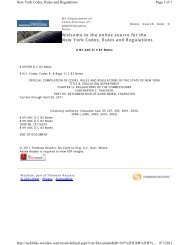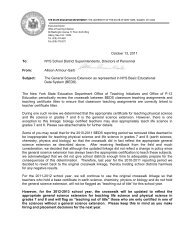ESL Learning Standards - Higher Ed - New York State Education ...
ESL Learning Standards - Higher Ed - New York State Education ...
ESL Learning Standards - Higher Ed - New York State Education ...
You also want an ePaper? Increase the reach of your titles
YUMPU automatically turns print PDFs into web optimized ePapers that Google loves.
Advanced<br />
In pairs, students use Internet sources to find information<br />
about the mummification process, and take notes on the<br />
information that they find. They take on the role of “master<br />
mummifiers” and create a mummification manual (using<br />
web design software if available) describing the process for<br />
“apprentice mummifiers.” Students use illustrations and<br />
written details to describe each step of the process.<br />
Students use a teacher-created rubric to check each other’s<br />
work for sequential order, use of transition words, adequate<br />
detail, and clear directions. Students share their manuals<br />
with their native English-speaking peers in their global history<br />
class during the unit on ancient Egypt.<br />
Performance indicators: 1, 2, 3, 4, 5, 9, 10, 11, 12, 13, 15<br />
English Proficiency Level<br />
Transitional<br />
Students complete the Advanced task, but create their final<br />
manuals independently rather than with a partner. With<br />
the help of the teacher, the class creates a rubric, using the<br />
criteria listed in the Advanced task, and students peer edit<br />
one another’s work. Students finalize their manuals, and<br />
use them to present the process of mummification to their<br />
native English-speaking peers in their global history class<br />
during the unit on ancient Egypt.<br />
Performance indicators: 1, 2, 3, 4, 5, 9, 10, 11, 12, 15<br />
Students review car ads and TV or Internet commercials (if<br />
possible) and take notes. Then they discuss car features<br />
and advertising strategies, including persuasive language.<br />
They work in groups to script a TV commercial advertising<br />
an imaginary car that includes what the group thinks are<br />
the most important features. Groups write and rehearse the<br />
commercial, using advertising strategies and language identified<br />
in the first activity. They perform for the class while<br />
the teacher videotapes each one. Students watch the tape<br />
and use a rubric to analyze their performances; criteria for<br />
the rubric include how convincing the commercial is, how<br />
well the features are described, and how effectively students<br />
use persuasive speech.<br />
Performance indicators: 1, 2, 3, 4, 5, 6, 7, 8, 10, 12, 14, 15,<br />
16<br />
Students review real car brochures the teacher obtains from<br />
dealerships to identify interesting car features and effective<br />
advertising strategies, including persuasive language. They<br />
work in pairs to create multipage sales brochures for an<br />
imaginary, ideal car, using the real brochures as models.<br />
Ads must include details about appearance, safety features,<br />
reliability, efficiency, etc. Using the brochures as visual<br />
support, students stage sales presentations to the class<br />
highlighting unique features of their cars. Students evaluate<br />
one another’s ads and presentations, using a student-generated<br />
rubric developed from the criteria identified in the first<br />
activity.<br />
Performance indicators: 1, 2, 3, 4, 5, 6, 7, 8, 9, 10, 12, 13,<br />
14, 15, 16<br />
<strong>ESL</strong><br />
1<br />
Comm<br />
CLASSROOM<br />
TASKS<br />
Sample Classroom Tasks 91
















